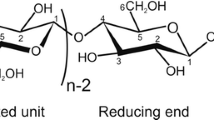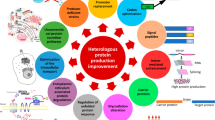Abstract
Monoclonal antibodies have been used to determine the presence of cellobiohydrolases I and II (CBH I and II), and endoglucanase I (EG I) on the surface of conidia from Trichoderma reesei QM 9414 and RUT C-30, and 8 other Trichoderma species. For this purpose, proteins were released from the conidial surface by treatment with a non-ionic detergent (Triton X-100 and β-octylglucoside), followed by SDS-PAGE/Western blotting and immunostaining. Both CBH I and II were clearly present, but — unlike in extracellular culture fluids from Trichoderma — CBH II was the predominant cellulase. In T. reesei EG I could not be detected. The higher producer strain T. reesei RUT C-30 exhibited a higher conidial level of CBH II than T. reesei QM 9414. In order to assess the importance of the conidial CBH II level for cellulase induction by cellulose, multiple copies of the chb2 gene were introduced into the T. reesei genome by cotransformation using PyrG as a marker. Stable multicopy transformants secreted the 2- to 4-fold level of CBH II into the culture medium when grown on lactose as a carbon source, but their CBH I secretion was unaltered. Upon growth on cellulose, both CBH I and CBH II secretion was enhanced. Those strain showing highest cellulase activity on cellulose also appeared to contain the highest level of conidial bound CBH II. CBH II was also the predominant conidial cellulase in various other Trichoderma sp. However, roughly the same amount of conidial bound CBH II was detected in all strains, although their cellulase production differed considerably.
Similar content being viewed by others
References
Baily MJ, Nevalainen H (1985) Induction, isolation and testing of stable Trichoderma reesei with improved production of solubilizing cellulase. Enzyme Microb Technol 3: 153–157
Ballance DJ, Turner G (1985) Development of a high-frequency transforming vector for Aspergillus nidulans Gene 36: 321–331
Bisaria VS, Mishra S (1989) Regulatory aspects of cellulase biosynthesis and secretion. CRC Crit Rev Biotechnol 9: 61–103
Brunette WN (1981) ”Western blotting”: electrophoretic transfer of proteins from sodium dodecyl sulfate — polyacrylamide gels to unmodified nitrocellulose and radiographic detection with antibody and radioiodinated protein A. Anal Biochem 112: 195–203
Combepine G, Turian G (1970) Activites de quelques enzymes associes a la conidiogenese du Neurospora crassa. Arch Microbiol 72: 36–47
Chakravarti DN, Chakravarti B, Chakrabarti B (1981) Studies on phospholipase activities in Neurospora crassa conidia. Biochim Biophys Acta 206: 392–402
Chanzy H, Henrissat B (1985) Unidirectional degradation of Valonia cellulose microcrystals subjected to cellulase action. FEBS Lett 184: 285–288
Chen CM, Gritzali M, Stafford DW (1987) Nucleotide sequence and deduced primary structure of cellobiohydrolase II from Trichoderma reesei. Bio/Technol 5: 274–278
ElGogary S, Leite A, Crivellaro O, ElDorry H, Eveleigh DE (1990) Trichoderma reesei cellulase — from mutants to induction. In: Kubicek CP, Eveleigh DE, Esterbauer H, Steiner W, Kubicek-Pranz EM (eds) Trichoderma reesei cellulases: biochemistry, genetics, physiology and applications. Royal Chemical Society, London, pp 201–211
Enari T-M, Niku-Paavola M-L (1987) Enzymatic hydrolysis of cellulose. CRC Crit Rev Biotechnol 5: 67–87
Farkas V, Greisk M, Kolarova N, Sulova Z, Sestak S (1990) Biochemical and physiological changes during photoinduced conidiation and derepression of cellulase synthesis in Trichoderma. In: Kubicek CP, Eveleigh DE, Esterbauer H, Steiner W, Kubicek-Pranz WM (eds) Trichoderma reesei cellulases: biochemistry, genetics, physiology and applications. Royal Chemical Society, London, pp 139–151
Glenn M, Ghosh A, Ghosh BK (1985) Subcellular fractionation of a hypercellulolytic mutant, Trichoderma reesei RUT C-30: localization of endoglucanase in microsomal fractions. Appl Envir Microbiol 50: 1137–1143
Gruber F, Visser J, Kubicek CP, DeGraaff L (1990) The development of a heterologous transformation system for the cellulolytic fungus Trichoderma reesei based on a PyrG-negative strain. Curr Genet 18: 71–76
Horikoshi K, Ikeda Y (1965) Studies on the spore coat of Aspergillus oryzae: conidia coat-bound β-glucosidase. Biochim Biophys Acta 101: 352–356
John R, Schiebler W, Greengard P (1984) A quantitative Dot-blot immunobinding assay for proteins using nitrocellulose membrane filters. Proc Natl Acad Sci USA 81: 1684–1687
Kolbe J, Kubicek CP (1990) Enzyme linked immunosorbent assay (ELISA)-based quantification and identification of the main components of the Trichoderma cellulase complex with monoclonal antibodies. Appl Microbiol Biotechnol 34: 26–30
Kubicek CP (1982) β-Glucosidase excretion in Trichoderma pseudokoningii: Correlation with cell wall bound β-1,3-glucanase activities. Arch Microbiol 132: 349–354
Kubicek CP (1987) Involvement of a conidial bound endoglucanase and a plasma membrane bound β-glucosidase in the induction of endoglucanase synthesis by cellulose in Trichoderma reesei. J Gen Microbiol 133: 1481–1487
Kubicek CP, Panda T, Schreferl-Kunar G, Messner R, Gruber F (1987) O-linked — but not N-linked glycosylation is necessary for the secretion of endoglucanases I and II by Trichoderma reesei. Can J Microbiol 33: 689–703
Kubicek CP, Messner R, Fritscher C, Strauss S, Kubicek-Pranz EM (1990) Regulatory aspects of formation and secretion of cellulases by Trichoderma reesei. In: Kubicek CP, Eveleigh DE, Esterbauer H, Steiner W, Kubicek-Pranz EM (eds) Trichoderma reesei cellulases: biochemistry, genetics, physiology and applications. Royal Chemical Society, London, pp 81–101
Kubicek CP, Mühlbauer G, Krotz M, John E, Kubicek-Pranz EM (1988) Properties of a conidial bound cellulase enzyme system from Trichoderma reesei. J Gen Microbiol 134: 1215–1222
Kubicek-Pranz EM, Gruber F, Kubicek CP (1991) Transformation of Trichoderma reesei with the cellobiohydrolase II gene as a means for obtaining strains with increased cellulase production and specific activity. J Biotechnol (in press)
Laemmli UK (1970) Cleavage of structural proteins during the assembly of the head of bacteriophage T 4. Nature 227: 680–685
Luderer M, Hofer F, Hagspiel K, Allmaier G, Blaas D, Kubicek CP (1990) A reappraisal of multiplicity of endoglucanase I from Trichoderma reesei using monoclonal antibodies and plasma desorption mass spectrometry. Biochim Biophys Acta 1076: 427–434
Mahadevan PR, Menon CPS (1968) Laminarinase of Neurospora crassa: enzyme activity associated with conidia and conidial wall. Indian J Biochem 5: 6–8
Maniatis T, Fritsch EF, Sambrook J (1982) Molecular cloning: a laboratory manual. Cold Spring Harbour Laboratory. Cold Spring Harbour, New York
Mischak H, Hofer F, Weissinger E, Messner R, Hayn M, Tomme P, Esterbauer H, Küchler E, Claeyssens M, Kubicek CP, 1989) Monoclonal antibodies against different domains of cellobiohydrolase I and II from Trichoderma reesei. Biochim Biophys Acta 990: 1–7
Niku-Paavola M-L, Lappalainen A, Enari TM, Nummi M (1986) Trichoderma reesei cellobiohydrolase II: purification by immunoadsorption and hydrolytic properties. Biotechnol Appl Biochem 8: 449–458
Shoemaker SP, Raymond JC, Bruner R (1981) Cellulases: diversity among imporved Trichoderma strains. In: Hollaender A (ed) Trends in the biology of fermentations for fuel and chemicals. Plenum, New York, pp 89–101
Teeri TT, Lehtovaara P, Kaupinnen S, Salovuori I, Knowles J (1987) Homologous domains in Trichoderma reesei cellulolytic enzymes: gene sequence and expression of cellobiohydrolase II. Gene 51: 43–52
Towbin H, Staehlin T, Gordon J (1979) Electrophoretic transfer of proteins from polyacrylamide gels to nitrocellulose sheets: procedure and some applications. Proc Natl Acad Sci USA 76: 4350–4354
Author information
Authors and Affiliations
Rights and permissions
About this article
Cite this article
Messner, R., Kubicek-Pranz, E.M., Gsur, A. et al. Cellobiohydrolase II is the main conidial-bound cellulase in Trichoderma reesei and other Trichoderma strains. Arch. Microbiol. 155, 601–606 (1991). https://doi.org/10.1007/BF00245356
Received:
Accepted:
Issue Date:
DOI: https://doi.org/10.1007/BF00245356




